By Steven Law, P.Eng., Resilient World Institute; and Greg Young, B.Eng., EIT., MNP, Energy & Utilities
Imagine the scenario where you finally get through the complex stages of building an electricity generating power plant, plug it into the grid, and then… not be allowed to generate the power you are able to produce. This exact scenario can be a common event with renewable energy technology in Ontario, Canada, with some years resulting in abandoning up to 26% of the electricity we are able to produce with wind and solar.
A disadvantage with renewables that we’ve all heard before, particularly with wind and solar, is their intermittent power production due to their weather-dependent fuel source. This means that the temporal generation of renewable energy can be misaligned with grid demand. The solution to this problem is using energy storage to capture our renewable energy production when it is available to then use later during periods of high grid demand or otherwise when the wind or sun is not available.
In Ontario, we have another unique use-case for energy storage with renewables — to reclaim a significant portion of the available energy that we currently abandon. The following article will cover the topic of renewable energy being abandoned or “dispatched down” during the times when our grid is not able to accept the energy capable of being produced from our renewable sources. This is free, clean energy that we are abandoning due to the temporal misalignment of supply and demand on the grid. Storage technology is required in Ontario both for the intermittency of renewables and to reclaim the available energy that we are currently abandoning.
Dispatch down is necessary to balance the grid
Dispatch down refers to an electricity generator (e.g., natural gas, wind, solar, etc.) either lowering its power output to the grid or shutting down completely, which can occur for a number of reasons. A common scenario is simply a supply-and-demand issue, where consumer demand decreases and we no longer need to supply as much electricity to the grid (often during nighttime, or in milder seasons like Spring and Fall). A less common, and more troubling, scenario is when renewable energy production adds too much electricity to the grid, either causing a strain on our transmission infrastructure or creating a scenario where we have too much supply compared to demand and the order is given to curtail production.
Quantifying our clean energy abandonment
The Independent Electricity System Operator (IESO) provides data from its annual reviews, which specify how much electricity we have been dispatching down beginning in 2015. The data includes wind power values from 2015-2016, and a value for all renewables combined beginning in 2017, summarized below.
Based on the information presented above, you can see Ontario is dispatching down a considerable amount of the renewable energy that we are capable of generating, which is certainly not ideal for achieving clean electricity goals.
This abandonment of available clean electricity also has quantifiable climate change effects. In an ideal situation, we would have energy storage on our grid that would store this power, instead of abandoning it and replacing it later with natural gas peaking plants. Large-scale energy storage may not yet be feasible, but it is worth having the conversation to highlight the urgency for energy storage on our grid. In this ideal situation, we could assume the stored electricity could be used during times of high grid demand when natural gas peaking plants are required, which would offset the carbon emissions from these natural gas peaking plants.
The carbon emissions impact of dispatching down renewables and operating natural gas peaking plants
If we look at the available energy production that is dispatched down, we can convert the numbers to an equivalent amount of carbon emissions equivalent to the power being generated by natural gas peaking plants. The conversion uses data from the U.S. Department of Energy, which estimates the average emission factor from natural gas power generation at 429 kg CO2 per MWh of electricity produced. The avoided carbon emissions available from reclaiming our abandoned renewable power is shown below.
To put this into perspective, the total amount of greenhouse gas emissions associated with Ontario’s electricity production in 2019 was approximately 4.0 Megatons of CO2, so the ability to save around 1.0 Megatons of CO2 from reclaiming the dispatched down wind and solar power would have a major impact.
Ontario also produced 9,513 GWh of electricity from natural gas in 2019, so again, being able to reduce this by recovering over 2,000 GWh of abandoned renewable power would have a major impact on reducing carbon emissions from our grid.
Ontario’s unique low carbon baseload power
Ontario has been a leader in nuclear electricity generation for many years, including significant milestones like 61% of our electricity being produced from nuclear power and Bruce Power being the world’s largest operating nuclear facility. Nuclear power provides “baseload” power for the province, which is a constant supply of electricity at all times of the day, year after year, to keep the province powered during night and day. Other types of power generation that we use include hydropower for baseload and peaking, renewable energy that provides power based on the weather, and natural gas peaking plants that supply the remaining electricity required to meet our electricity demand. This stack up of various power generation types is shown below for a typical summer day.
Nuclear power is a reliable, low carbon source of electricity, making it great for baseload power. One thing to note about nuclear power is that it doesn’t typically have the ability to change its output on demand, nor does it get shut down regularly, meaning it is producing a constant amount of power all of the time, regardless of consumer demand.
Why is this nuclear information important when discussing the dispatching down of our renewable power production? The IESO states in its year-end reviews that one of the reasons we are required to do this is because “[variable generation] dispatch also helps avoid nuclear shutdowns during periods of surplus baseload generation.” This is a key factor as it highlights the unique situation in Ontario due to our large amount of nuclear power. It is also important to note that hydropower also contributes to a significant amount of baseload power, but not near the amount of nuclear power. Furthermore, hydropower has a certain amount of flexibility regarding generation output that nuclear power does not have.
Based on the information gathered regarding Ontario’s current baseload power situation, we can postulate that most of the renewable energy abandonment is occurring during low grid-demand times, when the grid demand is close to or below baseload output.
For clarity, the intent of this article is not to discuss how to reduce low carbon baseload power such as nuclear, but rather it is intended to introduce the urgency in solving the energy storage problem to capture all of the renewable energy we can generate to create a lower carbon electricity grid by reducing natural gas peaking generation.
The dynamics between baseload and renewables
It has been postulated so far that much of the renewable power we need to dispatch down is due to the temporal relationship between our baseload power and grid demand. During these low-demand, surplus-baseload supply times, we cannot allow an increase in renewable power output putting even more power on the overloaded grid, introducing the requirement to dispatch down renewables. To test this theory, we gathered hourly electricity supply and demand data from the IESO for 2015 and 2018 to compare wind output during various consumer demand buckets to see if output from wind would change as our demand got lower. Wind data is used for this analysis as it is the most common type of renewable power that is dispatched down. Wind power is also able to produce electricity at all times of the day, so it is more likely to be producing power during our low demand times at night (in contrast to solar which produces power only during the day, when we typically need the power).
We are comparing 2015 with 2018 due to our amount of installed wind power increasing during this time as part of the province’s plan to phase out coal power (8,982 GWh generated in 2015 | 10,712 GWh generated in 2018) and the understanding that dispatching down was relatively limited in 2015 but quite significant in 2018.
Another thing to keep in mind is our installed nuclear capacity, which is typically between 8 to 12 GW depending on whether we are refurbishing reactors at any given point in time. The grid demand scenario that is important to assess is less than this 12-GW level when we might have a supply surplus from nuclear (and hydropower) baseload. The summary of wind data and Ontario grid demand data during various grid demand bucket sizes is shown below.
Based on the information provided above, we see a new trend emerging in 2018 where wind power production at low grid demand is dispatched down, even though we had more wind power installed. This is evident by the higher amount of wind generation at higher grid demand periods. This average wind production significantly reduced at low grid demand clearly shows the impact of dispatching down our wind power when we don’t have the demand for this electricity.
The other variable listed in the above graphic is HOEP (Hourly Ontario Energy Price), which we use to monitor real time wholesale electricity prices in the province. What you will notice is the price for electricity increases as demand increases, as that is when we are adding more power to the grid, increasing the total amount of generators participating in the market. For reference, the time of use pricing scheme we use for retail electricity prices is based on the HOEP.
Diving deeper into the data
To further explore how we dispatch down renewables (particularly wind power), we dove deeper into the hourly electricity supply data provided by the IESO to pinpoint exact moments when wind power was being curtailed. The 2018 data was explored as it was one of the years that, as described above, showed signs of a large amount of renewable abandonment.
The analysis involved identifying when baseload supply (nuclear plus hydro) was greater than grid demand, and observing (on an hourly basis) how this affected wind power output. In theory, with already having excess baseload power, there shouldn’t be room to add more supply through renewables, so we should see a dramatic decrease in wind output. In practice, this is exactly what we found on numerous instances, with selected examples of this occurrence shown below in May and June of 2018.
May 2018 wind power dispatch down example
June 2018 wind power dispatch down example
The above scenarios were found numerous times in the hourly data — nearly 20 times in May alone! This is an important note, as the above scenario could be a coincidence with the wind speed simply lowering at this time, but after noticing this pattern occurring frequently in the data, it can be postulated that it is not just the weather causing these major reductions in wind output that are coincident with low demand periods.
Price impact of grid supply and demand dynamics
During these times of over-supply and wind dispatch down, the HOEP follows some unique trends. In Ontario, we know the HOEP increases as demand increases. In the case of grid demand decreasing below supply, the HOEP will actually become negative, meaning the IESO has to pay to get rid of our excess electricity, which is not an ideal situation. This occurrence is visualized for selected examples in the below tables, with the low HOEP highlighted during the wind dispatch down events.
Based on the information provided above, we see how the HOEP decreases during times of surplus baseload supply (primarily at night), causing disadvantageous market situations when the HOEP is zero, or even negative. If we had energy storage on the grid, a significant portion of this excess renewable power could be stored for later use to avoid negative pricing and the need to dispatch down.
Dispatch down seasonal trends
While wind power (and solar) could be dispatched down anytime of the year depending on grid supply-demand dynamics, the most common time is during the spring and fall seasons. During this time of year, our grid demand is most likely to decrease below the baseload supply due to favorable weather conditions, which lower the requirement for mechanical heating and cooling. When our grid demand decreases, it would also be expected that the HOEP decreases due to supply and demand market mechanisms. This is illustrated below by analyzing the monthly grid demand and average HOEP in 2018.
Based on the information provided above, we can clearly see the grid demand increases in the summer and winter months when our requirement for mechanical cooling versus lighting and heating increases, respectively. The above graph also demonstrates the lower grid demand and HOEP during the spring and fall months. Finally, the above graph illustrates a “U” shaped pattern with wind power production, with the colder months (January – April and October – December) producing significantly more electricity due to the higher air density and higher prevailing wind speeds. Power curtailment or dispatch down in the summer would be less frequent as grid demand is high and wind generation is lower due to prevailing atmospheric conditions.
Energy storage can shift dispatch down from renewables to natural gas to reduce carbon emissions
The clear solution to solve the problem of renewable energy abandonment due to surplus low carbon baseload generation while reducing carbon emissions from natural gas peaking plants is energy storage (e.g., batteries, hydrogen, pumped hydro, compressed air, etc). Energy storage has always been cited as a solution to take some of the intermittency out of renewables. We now also know that in jurisdictions such as Ontario with significant quantities of inflexible low carbon baseload generation, energy storage can reclaim abandoned renewable power when we don’t need it during periods of low grid demand and deploying it during periods of high demand to curtail natural gas peaking plants instead. Finally, energy storage doesn’t only need to be used for renewables. In Ontario’s case, when demand drops below baseload supply, why not also use energy storage to capture this surplus baseload nuclear and hydro power for later use to avoid carbon emissions from natural gas peaking plants?
Energy storage is already a hot topic these days, and now we have more reasons to urgently add it to our grid.
Steven Law, P. Eng. is an instructor at Resilient World Institute where he teaches a 1-day short course on renewable energy and energy storage.
Greg Young, B.Eng., EIT. is a mechanical engineering graduate from the University of Guelph, with a specialization in sustainable energy systems. Greg now has a career in the energy consulting industry and writes articles on various energy sector topics in his spare time.
Filed Under: Featured


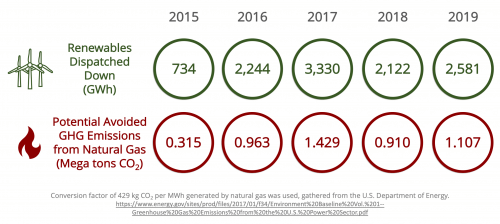

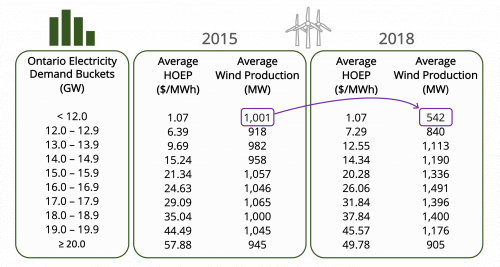
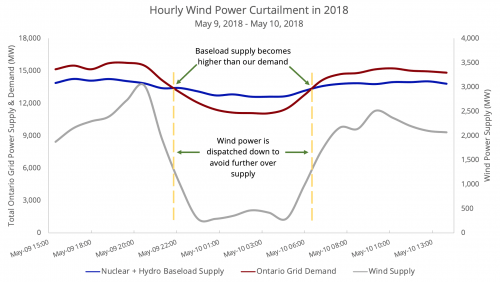
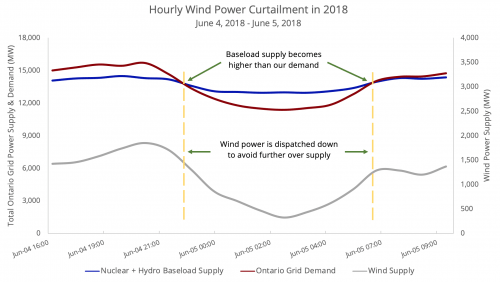





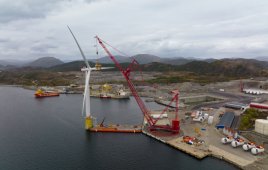
Instead of energy storage how about simply changing the pricing of electricity to encourage end-users to move their usage to when there is excess electricity.